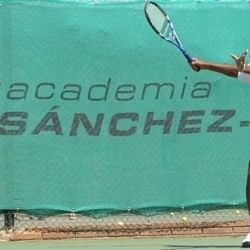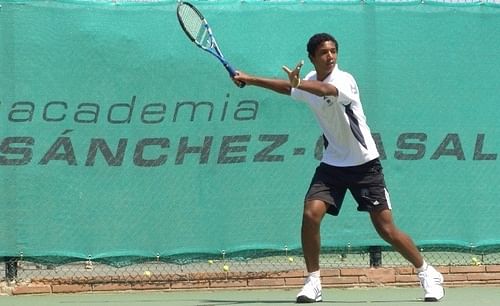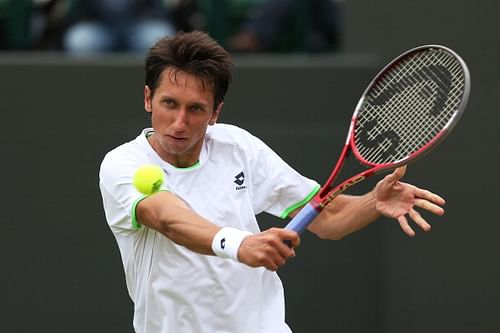
Chennai Open: The triumphs and disasters of qualifying
“Vaa da, Ram!”

The solitary cry of encouragement (“Come on, Ram!” in Tamil) came from the portly man seated directly in front of me, as he excitedly jumped in his seat and applauded with all his might. His shout managed to stir the sprinkling of spectators in the court, and a collective cheer went up as they saw their player rise up to continue play after an extended injury break.
It was the second round of qualifying at the Chennai Open, and spectator interest was mainly focused around the local boy, Ramkumar Ramanathan, as he battled Mikhail Elgin of Russia under the blazing afternoon sun. Ramkumar is a tall, lanky 19-year old, currently ranked 519 in the world. He plays with intensity and purpose, and has quite a few impressive shots in his repertoire. In all likelihood, he is the flag-bearer for the next generation of Indian tennis players on the circuit. Today, he made important strides in his fledgling career as he led Mikhail Elgin by a set, before the extreme conditions temporarily laid him low. As he lay stretched out on the court with the tournament physio attending to him, his opponent crouched at the other end of the court, also exposed to the sun, and distractedly watched the proceedings of another qualifying match taking place on the adjacent outside court. It was a typical scene from the life of a tennis professional used to the grind of the qualifiers.
The qualifying rounds played prior to the beginning of any ATP event, not just the Chennai Open, always have a dramatically different tone and flavor compared to the main tournament. None of the hype which surrounds the main event ever seems to filter down here. These are matches played in anonymity, with no grand entrances or exits, no fan followings, no electronic scoreboards, limited number of linesmen. It is raw tennis, stripped to the basics. But the stakes involved in these matches remain incredibly high. A series of good wins could transport the competitor to the next level, and make his career. A single loss though, would be another doubt raised about the overall ability of the player.
The kind of tennis players you come across in the qualifiers are also a breed in themselves. These are people rooted in the realities of the grind that is professional tennis. These are players who compete day in and day out all over the world, but still remain nameless and faceless to the average tennis follower. They continue to fight these battles to improve their rankings at the lower end of the world’s best tennis players. Winning three successive qualifying matches might give them the privilege of competing in the main draw, where they would be the likeliest candidates to bow out in the first round. Nevertheless, they fight on, for the ranking points it would provide (a qualifier for the Chennai Open main draw gets 12 ATP points) and the prize money that can be won (a qualifier for the Chennai Open main draw is assured of $ 4,115). A loss here, on the other hand, would mean a return to oblivion and another journey to another stop on the tennis calendar. There remains something tragic about these sportsmen, and their everyday triumphs and disasters with qualification.

Sergiy Stakhovsky
The most common type of tennis player you see in the qualifiers is the journeyman. This is the player who has made a career out of playing on the fringes of the world’s tennis elite. You are likely to see him playing a Challenger event one week, and the qualifiers of an ATP 250 tournament the next. He lives for that rare moment when he suddenly finds himself in the spotlight, like Sergiy Stakhovsky at Wimbledon in 2013, after his victory over Roger Federer. More often, you are likely to see him struggling to make it to the main draw of tournaments, like Sergiy Stakhovsky at Chennai this week, where he lost in the first round of the qualifiers.
Another personality encountered on the qualifying circuit is the player returning from injury. These are players returning to the game after long periods of enforced absence. The qualifiers are a temporary phase for these competitors, as they work their way up the ladder to reclaim their due spot in the tennis hierarchy. Of course, such types are not quite often seen, especially with protected rankings being an option for players these days.
A more common personality seen in the qualifiers is the local player. These are promising players from the region where the tournament is played, who are drafted into the qualifiers at the discretion of the organizers. These players often have the most to gain, with the local support they know they can count on, and the freedom of knowing they have nothing to lose.
Ramkumar, at the moment, belongs to this category, and it showed in his play today. Cheered on by the home crowd, he took to the court again after his time-out, with the match delicately poised at 6-3, 6-5. On Elgin’s serve, Ramkumar forced a couple of errors to take a 0-30 lead. The cheers from the spectators grew even louder. Elgin came back to level the game at 30-30. The atmosphere had suddenly become tense. On the next point, the Indian played a spectacular backhand passing shot to leave his opponent stranded in the forecourt. Serving match point down, Elgin came up with a double-fault, and Ramkumar found himself safely through as the only Indian in the final round of qualification. As he fist-pumped his way to the net, the spectators reserved their loudest roar yet for the local boy. The man in front of me was now up on his feet, and dancing a victory jig.
Tomorrow will be a new day for Ramkumar, with one more life-or-death qualification round in store. But just for a moment there at the end today, it almost felt like he had left the grind of qualifiers behind, and won a main draw match for his home crowd.